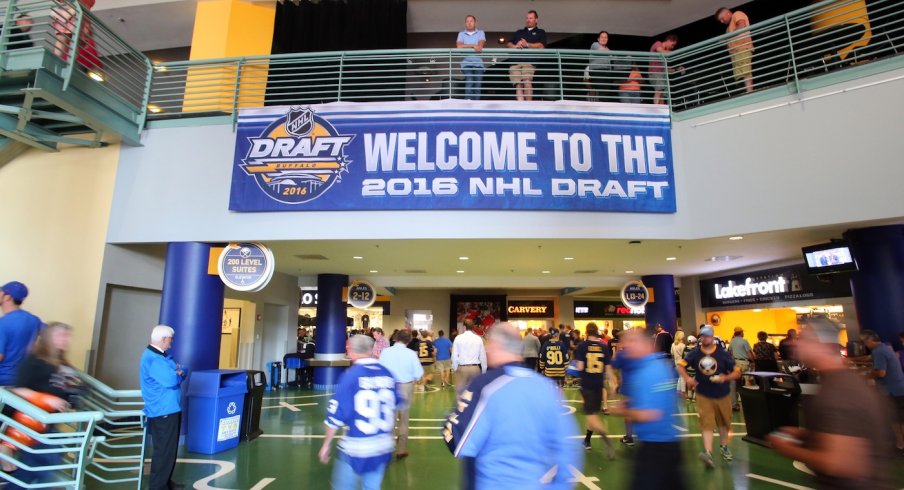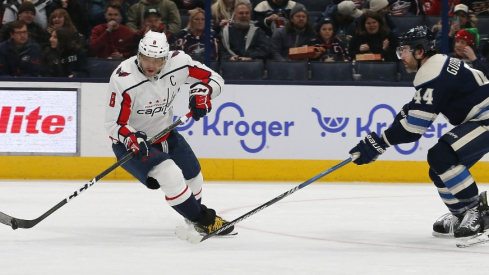Each team in the league has a different strategy when drafting players. Whether it be filling a need or just selecting the best player available, it all has its merits. One move that constantly sets teams back time and time again is missing in the draft. The Columbus Blue Jackets are picking the latest they ever have in the first round, only making their first-round pick all the more important.
Picking players that have been historical misses will make the process much more difficult than it needs to be.
These are the three players that you'd want the Blue Jackets to avoid if they stick at the 24th pick in the 2017 NHL Draft.
Matthew Strome - Hamilton Bulldogs, OHL (33rd Ranked North American Skater by NHL Central Scouting, 29th Overall by Future Considerations)
The very first comment you'll read or hear about this iteration of Strome is the familial connection he has to the league. His brothers Ryan and Dylan were both highly sought-after players that tore up the OHL. Ryan currently plays for the New York Islanders and Dylan will be joining the Arizona Coyotes next season.
While the other two brothers scored plenty in the OHL, Matthew wasn't able to notch over a point per game this season. The number may seem arbitrary, but it is important when selecting first round players; it shows that they are way ahead of the developmental process. Similar players to Matthew Strome are selected in later rounds because they are seen as a bit more of a risk.
Here is what Curtis Joe of Elite Prospects had to say about the youngest Strome brother:
A big, skilled winger that plays a complete and consistent game. Battles hard for puck possession and is relentless on both the power play and penalty kill. Plays a hard-nosed game and uses his size to establish his presence around the net. Has good hands, an accurate shot, and zero compromise hockey sense. His skating and overall balance off the rush and in-transition is a work in progress that is continuing to get better by the day. That being said, his vision is excellent and his offensive talent is apparent; he is able to play at a fast pace. Being able to keep up is a big part of that, and, moving forward, he has the potential to develop into a strong two-way winger that is hard to play against and can be relied on in all situations.
Gare Joyce of Sportsnet when talking to one anonymous OHL scout got the most succinct evaluation of his play. Short and sweet.
Seeing him three times [this season], if he’s a prospect at the next level for me or just a really good junior whose skating keeps him out of the league. “His brother [Dylan] wasn’t a great skater in his draft year, but you had a sense that it was just a matter of strength—if he put the work in, then it was going to improve, which is exactly what happened in the season after his draft year, a big step up.
Skating didn’t become a strength [for Dylan], but it stopped being a real issue. But [Matthew] has a whole other problem. Technically it’s sort of painful to watch. He has a short, choppy stride. It’s not clear how much you can improve it with added strength and physical maturity.
He can't skate very well and he isn't over the magic "point per game" line in the CHL. That means you either deal with his poor skating in a league that emphasizes it or you try to restructure it. He is a risk from the start and he is going to get a long look late in the first round because of his name, but the Blue Jackets shouldn't be the team reaching for a later round talent in the first.
Michael Rasmussen - Tri-City Americans, WHL (5th Ranked North American Skater by NHL Central Scouting, 16th Overall Player By Future Considerations)
Every year before the draft, a hulking player is pointed to as the next big thing (pun intended). The size is subsequently overvalued and they don't value the other parts of their game at a similar level. Rasmussen isn't a player to just discount because of his play, he is instead a player that deserves more nuance. He may very well be the most polarizing player in the draft.
He is ranked all over the place by various scouting services. Most have him at a first round grade. The lowest of the bunch is an analytically-based website, the Canucks Army. They point out how disconcerting it is that Rasmussen scores most of the time on the power play and not a whole lot 5-on-5 (he only put up 15 even strength points the entire season). That is enough to make you question his skill set and who he is at a player -- especially if he wants to be considered as a first-round talent.
This from Future Considerations talks about the different facets and ways to evaluate Rasmussen:
A big, skilled forward who uses his size well…has improved his skating substantially from his midget days…for a player his size, he moves phenomenally well, smoothly and with impressive power…does a very good job of consistently getting to the greasy areas of the ice; he wins a lot of battles in those areas due to his size and reach…goes to the net and blocks the goaltender’s view while looking for deflections and rebounds…not flashy hands, but can carry the puck using his body extremely well to protect it…has underrated vision and playmaking ability…needs some work on his shot as he currently lacks consistent accuracy and quickness in getting it off his blade…just knows how to utilize his strengths to make a difference…uses his reach to disrupt opponents and get into lanes…willing to block shots…has a ways to go, but could be special and has loads of upside.
Kevin Olexson of McKeen's Hockey (paywall alert) also has some issues with the way that Rasmussen plays and gets his points.
Michael Rasmussen is a big bodied left handed center who scores goals. He has a great work ethic, and his physicality and shot are already pro ready. He has a compelling combination of power and skill, and he excels in close around the net. His statistics are impressive, as he scored 32 goals in 50 games, but if you watch the vast majority of his goals, they are tap ins from up close or around the crease. I would expect him to dominate more than he does, and he excels as a specialty teams player on the power play as he does not produce as well at even strength and will struggle at a higher level of play. If drafted very high, he may disappoint, as he projects as more of a middle six forward, providing a strong physical game with checking ability.
Much like Strome before him, Rasmussen isn't a bad player. He just has a red flag to his game that shouldn't warrant a first round selection. There is enough there to select him but development will take longer than usual with having to work on different parts of his game. He may very well be selected early in the first round, and could also be a draft day story to watch if he begins to drop in the order.
Shane Bowers - Waterloo Blackhawks, USHL (16th ranked North American Skater by NHL Central Scouting, 31st Overall Player By Future Considerations)
Bowers was a highly sought-after player being courted in multiple junior leagues, at one point being selected near the top of the QMJHL draft. He turned it all down so he could play in the USHL and then go to Boston University in 2017-18.
For a player with a lot of hype, you'd expect him to dominate the USHL. He definitively did not by only putting up 51 points in 60 games. Much like the point per game threshold in other leagues, it isn't a great sign that Bowers was unable to do so in the USHL. According to Canucks Army, one of his closest comparisons as a player is Corey Tropp. Tropp is a fine AHL player but never made it close to being a serviceable NHL player. You need better than that when selecting in the first round.
From Future Considerations on Bowers:
A solid 200-foot player who works hard…adequate top-end speed that will only improve as he gets stronger…balanced on his skates and when he explodes, he can create breaches in the other team’s defense…shows good initial burst…plays with a lot of gumption and makes life hard for opponents…willing to play in the dirty areas of the ice…a nice ability to read the play…does a good job of using his body to protect the puck…hands are not overly flashy, but he does a good job of using his body to protect the puck…dangerous as he takes a quick step out from the wall to the front of the net or comes from behind the net to get off a quick shot…intelligent decision-maker who moves the puck well and makes the right choices…defensively, he plays with some grit, making life tough on his opponent…patiently lets the play come to him…just a real versatile difference-maker at both ends of the rink.
Jeff Marek of Sportsnet also gives his take on Bowers.
[Bowers] doesn’t have one thing that stands out about his game, but is good at a number of things. Plays the full rink and brings a strong work ethic to every game.
Bowers produced mostly at even strength which makes him a solid bet at the next level, but without good production to back him up, it may be in the bottom six. Those players are fine but they can be found all over the draft.
Ideally, you want to get top six players in the first round. None of these players above feel like anything special, which is a problem for a team aiming to draft and develop within its system and eventually win the Stanley Cup.


